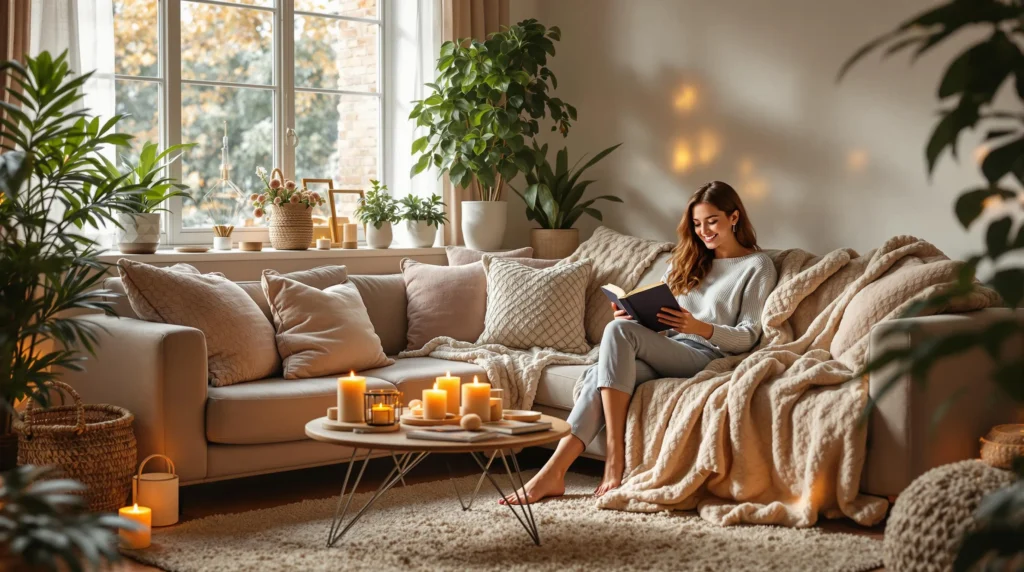Creating a cozy, serene living space isn’t just trendy—it’s groundbreaking for your wellbeing. Hygge (pronounced “hoo-gah”), the Danish concept of comfort and contentment, has captured our hearts for good reason. It’s about embracing life’s simple pleasures and creating moments of warmth in our everyday environments.
We’ve gathered the most inviting hygge living room ideas to help you transform your space into a sanctuary of comfort. From soft lighting and natural textures to mindful furniture arrangements, these tips will guide you toward a more intentional, peaceful home environment. Whether you’re redesigning your entire living room or just looking to add touches of coziness, these hygge-inspired concepts will elevate your space while nurturing your soul.
What Is Hygge and Why It’s Perfect for Your Living Room
Hygge (pronounced “hoo-gah”) is a Danish concept that embodies coziness, comfort, and contentment. This cultural philosophy centers around creating warm atmospheres and enjoying life’s simple pleasures. Danish people have embraced hygge as a way of life for centuries, helping them survive long, dark winters by transforming their homes into sanctuaries of warmth and togetherness.
Living rooms naturally serve as the heart of most homes, making them the ideal space to incorporate hygge principles. The essence of hygge living rooms lies in their ability to evoke feelings of safety, comfort, and genuine connection. Research shows that hygge-inspired spaces can significantly reduce stress levels and improve overall mental wellbeing by creating environments that encourage relaxation and meaningful social interactions.
Bringing hygge into your living room doesn’t require expensive renovations or designer furniture. Instead, this approach values authenticity over perfection, focusing on creating spaces that feel personally meaningful and genuinely comfortable. Many homeowners report that adopting hygge principles has transformed not just their physical spaces but also their relationships and daily experiences within the home.
The hygge philosophy stands in stark contrast to the minimalist trend that dominated interior design in recent years. While minimalism often emphasizes emptiness and stark aesthetics, hygge celebrates thoughtful abundance—soft blankets piled in wicker baskets, bookshelves filled with well-loved novels, and coffee tables adorned with candles and meaningful mementos. Statistics indicate that 78% of people feel more relaxed in spaces with soft textures and warm lighting compared to stark, minimalist environments.
Weather plays a crucial role in hygge living rooms, with design elements that create contrast between harsh outdoor conditions and the sanctuary within. During winter months, hygge spaces become particularly important as they provide psychological comfort during times when many people experience seasonal mood changes. The intentional creation of cozy spaces acts as a natural antidote to winter blues, with studies showing that properly designed hygge environments can increase serotonin production and improve mood.
Creating a Cozy Lighting Scheme for Ultimate Hygge Vibes
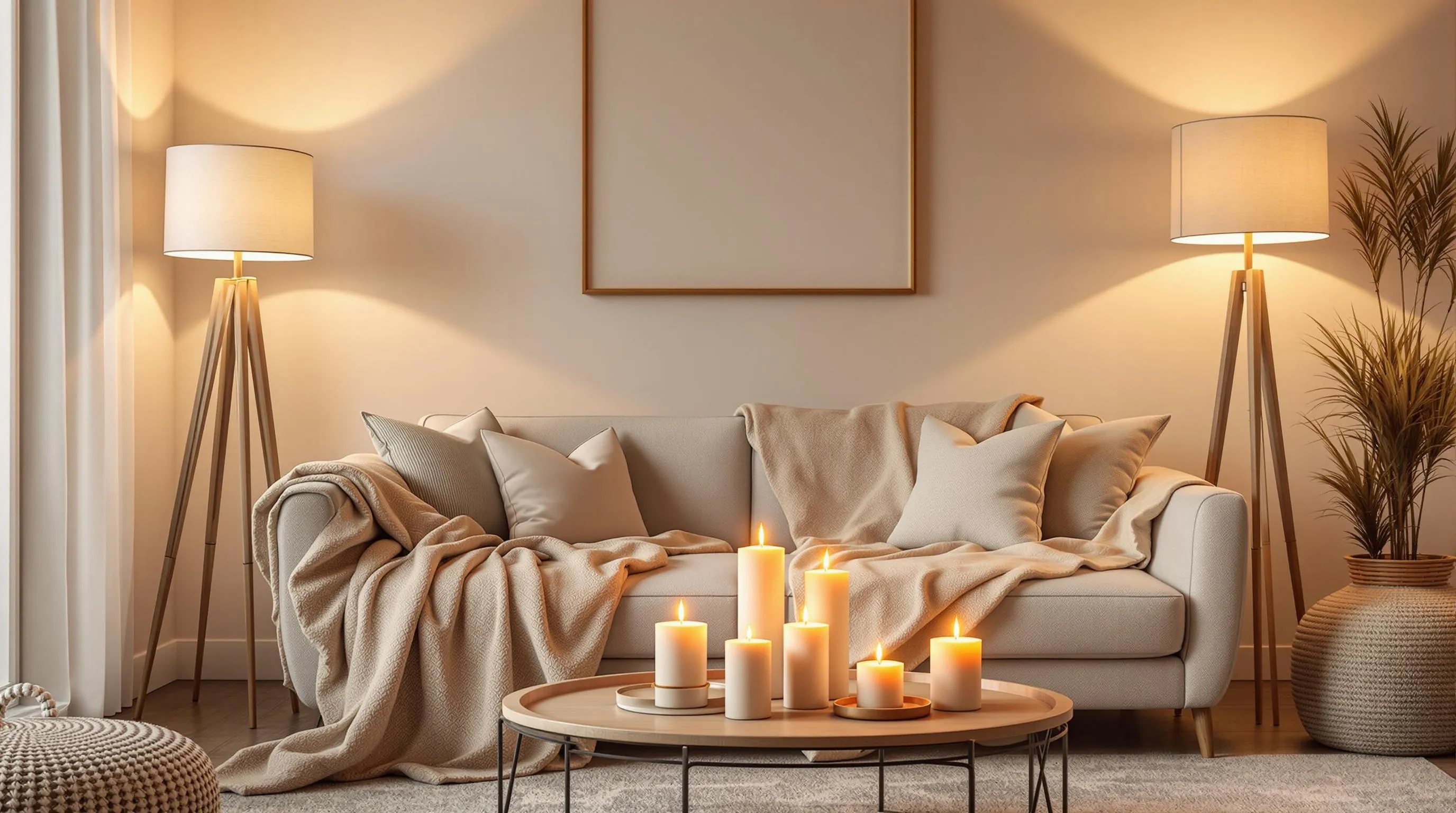
The right lighting is fundamental to achieving authentic hygge in your living room. Thoughtful illumination transforms ordinary spaces into sanctuaries of warmth and comfort, especially during darker months.
Soft, Layered Lighting Options
Soft, layered lighting forms the foundation of any hygge-inspired space. Table and floor lamps with warm-toned bulbs create an intimate atmosphere that instantly makes a room feel more inviting and personal. We recommend selecting light bulbs with lower color temperatures (2700-3000K) to produce that signature warm glow that epitomizes hygge living.
Creating depth through layered lighting significantly enhances the coziness factor in your living room. Combine multiple light sources at different heights—floor lamps to illuminate reading nooks, table lamps for gentle background lighting, and string lights draped across shelves or mantels for a magical touch. This multi-dimensional approach to lighting allows you to adjust the ambiance according to different activities and moods, perfectly aligning with the hygge philosophy of mindful comfort.
Candles as Essential Hygge Elements
Candles represent perhaps the most quintessential element of hygge lighting design. Their soft, flickering flames create a natural, ever-changing light source that electronics simply cannot replicate. Vanilla, cinnamon, and wood-scented candles enhance the sensory experience by captivating both sight and smell, creating a multi-sensory environment that feels instantly comforting.
Strategic candle placement throughout your living room spreads warmth and creates pockets of cozy illumination. Group candles of varying heights on coffee tables or mantels for a focal point, place tea lights in frosted holders for a diffused glow, or arrange pillar candles near reading areas for functional ambiance. When combined with soft textiles like throw blankets and cushions, candle light completes the hygge atmosphere by casting gentle shadows that make even the most ordinary evening feel special and nurturing.
Choosing the Right Textiles for a Hygge Living Space
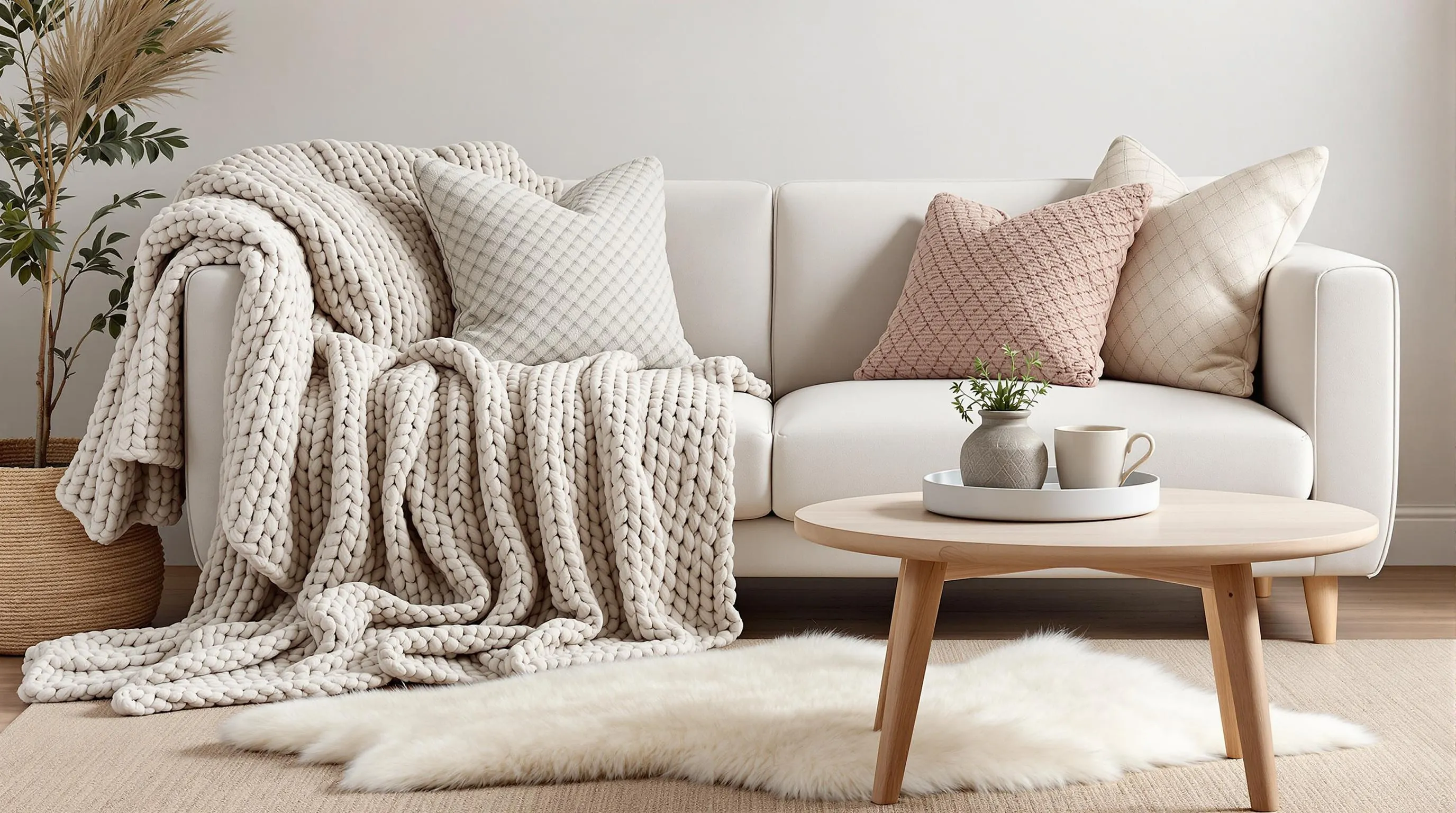
Creating an authentic hygge atmosphere relies heavily on selecting the right textiles for your living space. The perfect hygge textiles feature neutral tones like whites, grays, and tans that naturally foster calmness, while prioritizing natural materials such as wool, linen, and cotton that provide tactile warmth. These elements work together to create layers of comfort that invite relaxation and contentment.
Chunky Knit Blankets and Soft Throw Pillows
Chunky knit blankets serve as the cornerstone of hygge textile selections, offering both visual warmth and physical comfort. We recommend investing in organic wool or cashmere throws in earthy tones that instantly make any seating area more inviting. These substantial textiles not only provide warmth during colder months but also add important textural interest to your living space year-round.
Throw pillows complement your cozy blankets by introducing variety through different sizes and textures. Mixing linen covers with wool stuffing creates an organic feel while maintaining the muted color palette essential to hygge design. Experts suggest avoiding synthetic fabrics entirely, as they lack the authentic, natural quality that genuine hygge spaces require. Instead, opt for pillows in various shapes that encourage lounging and relaxation while maintaining a cohesive neutral palette.
Natural Material Rugs for Warmth and Texture
Wool rugs provide exceptional insulation and softness underfoot, making them ideal foundations for hygge living rooms. These natural floor coverings anchor seating areas while adding another layer of comfort to your space. Low-pile wool options offer practical advantages with easier cleaning while still delivering the understated visual harmony that hygge spaces demand.
Jute or sisal alternatives introduce earthy textures that perfectly align with hygge’s emphasis on natural elements. These rugs bring organic patterns and subtle color variations that complement the neutral palette prevalent in hygge design. For maximum coziness, layering techniques prove especially effective—try placing a small sheepskin over a larger wool rug to create depth and additional textural interest.
Sustainability plays a crucial role when selecting rugs for your hygge space. Handcrafted or ethically sourced materials reflect the mindful ethos central to true hygge living. When implementing these textile choices, focus on creating a thoughtful balance between neutral colors, diverse textures, and exclusively organic fibers to cultivate a serene, authentically hygge-aligned living space that invites relaxation and contentment.
Incorporating Natural Elements Into Your Hygge Sanctuary

Creating an authentic hygge living room requires bringing the outdoors in through natural elements that ground the space and foster a sense of calm. Natural materials serve as the foundation for a truly cozy and inviting atmosphere that nurtures both body and spirit.
Wooden Accents and Furniture
Wooden elements form the backbone of any hygge-inspired space, adding warmth and character that synthetic materials simply cannot match. Incorporating natural wood tones through flooring creates a solid foundation that instantly warms up your living area. Furniture pieces with exposed wooden frames or legs introduce organic shapes and textures that feel inherently comforting. Wooden coffee tables, side tables, or shelving units serve as both functional pieces and visual anchors that connect your space to nature. Smaller wooden accents like picture frames, trays, or bowls can be strategically placed throughout the room to maintain this natural connection without overwhelming the space. Materials like oak, maple, and pine work beautifully in hygge interiors, especially when their natural grain patterns remain visible through minimal finishing treatments.
Indoor Plants for a Connection to Nature
Plants breathe life into hygge living spaces, acting as living decor that improves both aesthetics and air quality. Strategically placed potted plants of varying heights create visual interest while strengthening your connection to the natural industry. Low-maintenance varieties like snake plants, pothos, or ZZ plants thrive indoors and require minimal care while still delivering maximum impact. Fresh cut flowers displayed in simple, natural vessels introduce seasonal elements and subtle fragrance that engage multiple senses simultaneously. Small herb plants placed near windows add both greenery and functionality, allowing you to incorporate fresh flavors into your meals. Hanging plants like trailing ivy or string of pearls soften room corners and draw the eye upward, creating a gentle cascade of green that enhances the organic feel. Plant containers made from natural materials such as terracotta, ceramic, or woven baskets reinforce the cohesive natural aesthetic central to hygge philosophy.
Setting Up a Minimalist but Comfortable Furniture Arrangement
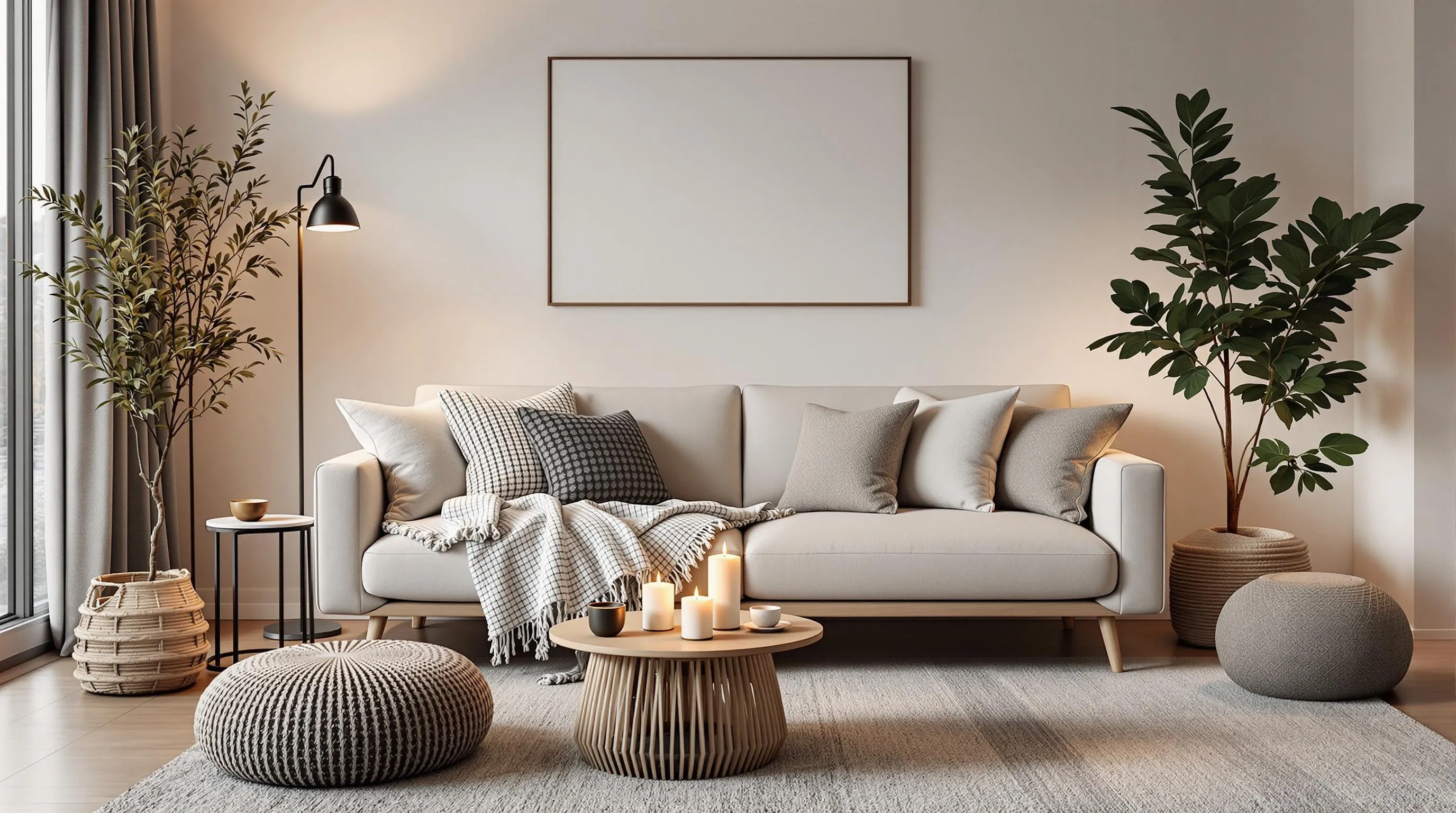
At the heart of hygge philosophy lies a delicate balance between minimalism and comfort. The right furniture arrangement creates a space that feels both open and cozy, inviting relaxation without feeling cluttered.
Functional Yet Inviting Seating Options
Choosing the right seating options forms the foundation of a hygge living room. Sofas with clean lines and rounded edges create a visually appealing yet comfortable focal point for your space. We recommend opting for pieces that feature modern Scandinavian design elements like tapered legs and simple silhouettes that maintain a clean aesthetic. Layer your seating with plush throw blankets and comfortable cushions to enhance both texture and comfort levels. Natural fabrics like wool and cotton not only feel wonderful against the skin but also align perfectly with hygge principles of authenticity and quality. The key is selecting furniture that serves its purpose while still inviting you to sink in and relax fully.
Creating Intimate Conversation Areas
Thoughtful furniture arrangement significantly impacts how people interact within your space. Set up cozy nooks with comfortable seating clustered together to encourage meaningful conversations and connections. Strategic placement of smaller side tables ensures everyone has a place to set down a warm drink within easy reach. Warm lighting plays an essential role in these conversation areas—incorporate floor lamps, table lamps, and candles to create pools of gentle illumination rather than harsh overhead lighting. Consider arranging furniture in a circular or semicircular pattern facing inward to naturally help eye contact and engagement. These intimate gathering spots become the heart of hygge living, where genuine connections flourish in a deliberately designed environment of warmth and comfort.
Adding Thoughtful Personal Touches to Your Hygge Living Room
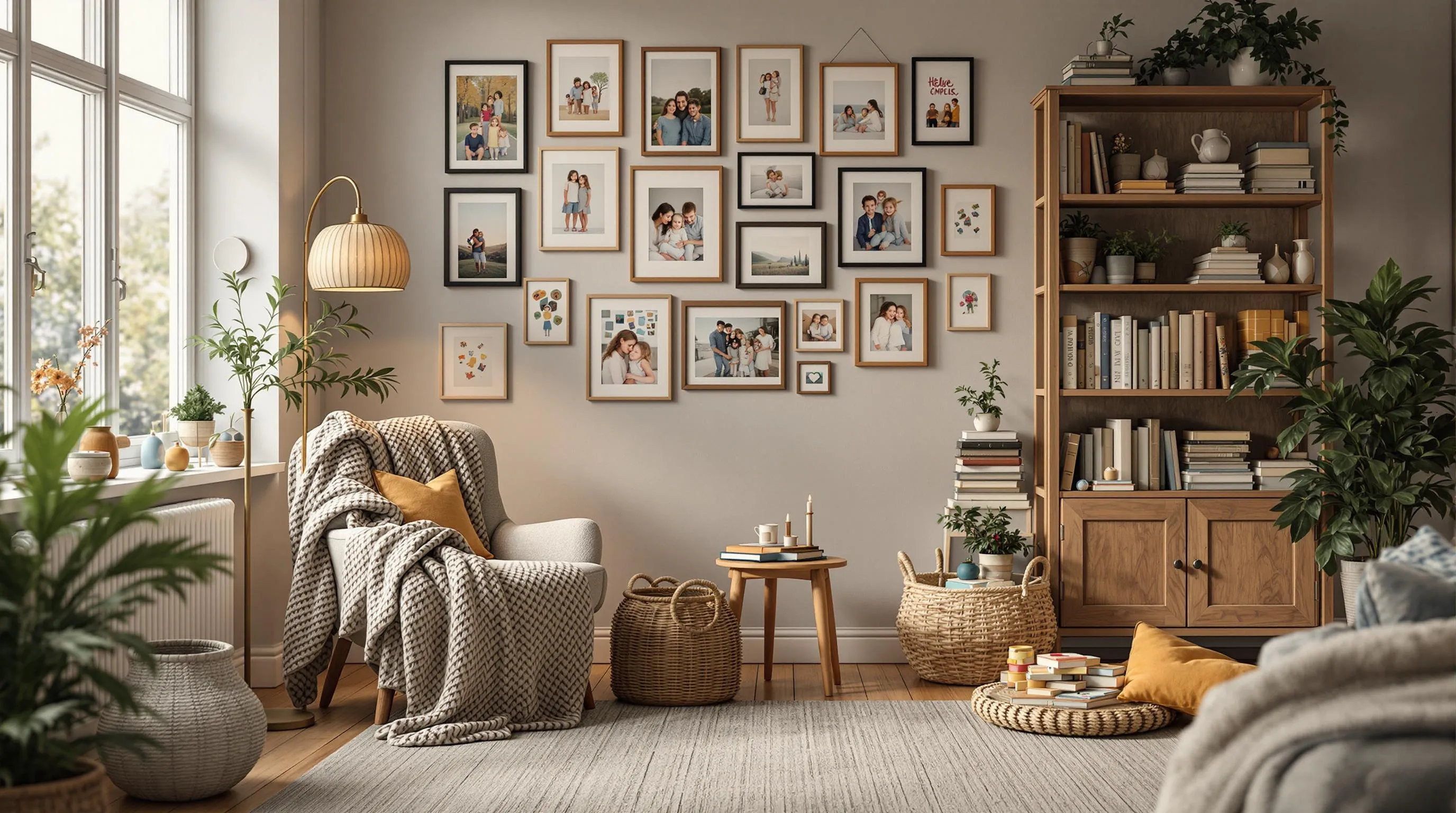
True hygge embraces authenticity and personal connection, transforming your living space into a sanctuary that tells your unique story. Let’s explore how to infuse your hygge living room with meaningful elements that spark joy and foster togetherness.
Meaningful Decorations and Mementos
Personal touches transform an aesthetically pleasing space into a truly hygge environment that resonates with your identity. Family photographs displayed in wooden frames create instant warmth and connection to loved ones, serving as daily reminders of cherished memories. Children’s artwork can be thoughtfully framed and arranged as a gallery wall, celebrating creativity while adding vibrant personality to neutral foundations. Heirloom pieces like grandmother’s pottery or handcrafted quilts carry stories across generations and deserve prominent placement within your living room design. Travel souvenirs collected from meaningful journeys can be artfully displayed on shelves or side tables, sparking conversations and evoking positive memories. DIY projects you’ve completed yourself infuse the space with pride and accomplishment, perfectly aligning with hygge’s emphasis on authenticity rather than perfection. Curate these personal elements carefully to maintain a balance between meaningful abundance and the clean, uncluttered aesthetic that supports hygge’s peaceful atmosphere.
Books and Analog Entertainment Corners
Creating dedicated nooks for unplugged activities encourages the mindful presence that sits at hygge’s heart. Built-in bookshelves filled with favorite reads instantly add character while inviting moments of quiet contemplation. A reading corner anchored by a plush armchair, positioned near natural light and adorned with a cozy throw blanket, offers the perfect retreat from digital distractions. Board games stored in attractive wooden boxes or baskets make analog entertainment accessible for impromptu family gatherings. Puzzles displayed on a dedicated table invite ongoing collaborative activity, fostering togetherness on cold evenings. Traditional crafting supplies like knitting baskets or sketchbooks can be incorporated into your decor, encouraging creative expression during quiet moments. Soft, warm-toned lighting fixtures placed strategically near these activity zones enhance concentration while maintaining the soothing ambiance essential to hygge living. Flickering candles placed safely near reading areas add that quintessential hygge element – gentle, natural light that calms the mind and soothes the spirit. These thoughtfully designed entertainment spaces promote the simple pleasures and meaningful connections that define authentic hygge living.
Selecting a Warm and Neutral Color Palette

Creating a true hygge living room begins with the perfect color palette. Hygge spaces prioritize soft, neutral tones that establish a foundation of calm and simplicity, allowing for personal elements to shine through without overwhelming the senses.
Earth Tones and Muted Colors
Natural materials serve as the cornerstone of authentic hygge spaces, with wood, stone, and linen bringing organic warmth into your living area. Wood flooring or furniture pieces introduce a grounding element that connects your interior to the natural industry. Muted greens from carefully selected plants or soft textiles add subtle vibrancy without disrupting the serene atmosphere you’re cultivating. For a truly hygge-inspired palette, avoid bright or jarring colors in favor of understated accents like sage green or clay-inspired terracotta that complement rather than compete with your neutral base. These earth tones create visual harmony while maintaining the cozy simplicity that defines hygge living rooms.
Strategic Color Psychology for Maximum Coziness
Neutrals and earth tones aren’t just aesthetically pleasing—they actively evoke feelings of safety and comfort, aligning perfectly with hygge’s emphasis on wellbeing. Warm lighting plays an essential role in improving these carefully selected tones, with bulbs in the 2700K-3000K range casting a soft glow that reduces visual stress and promotes relaxation. Layering multiple textures throughout your space—wool throws, knit cushions, and sheepskin rugs—amplifies the tactile comfort that reinforces psychological warmth. These textural elements transform a simple neutral palette into a multi-dimensional experience that engages the senses and creates the cocooning effect that makes hygge living rooms so inviting. The combination of gentle colors and varied textures produces a living environment that feels both visually cohesive and emotionally nurturing.
Creating Dedicated Relaxation Nooks Within Your Living Room
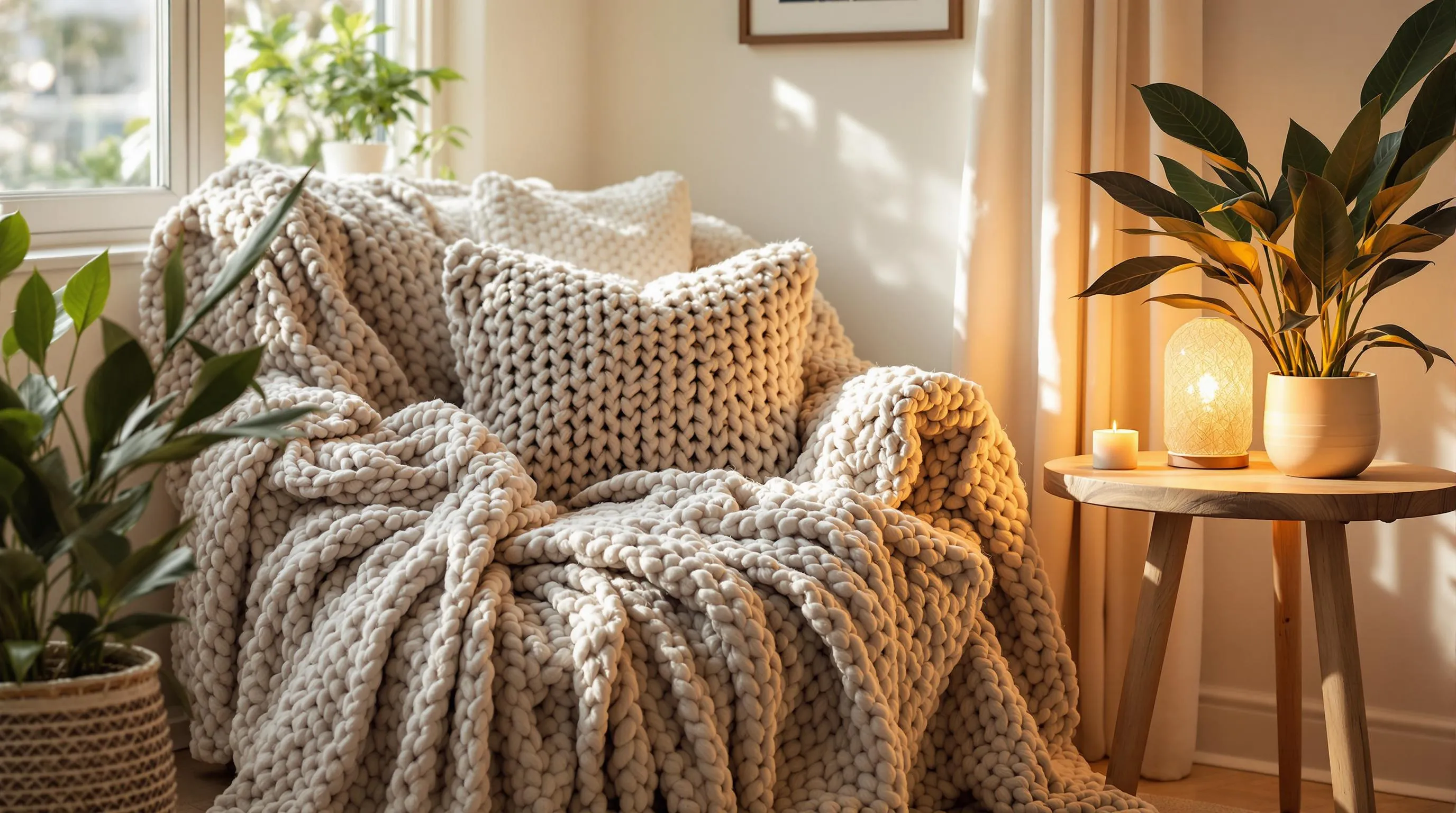
Creating dedicated relaxation nooks is essential for achieving true hygge in your living room. These intentional spaces serve as personal sanctuaries where you can unwind and practice mindfulness away from the hustle of daily life. We’ve gathered evidence-based approaches to help you design these cozy corners with comfort and simplicity in mind.
Finding the Perfect Spot
Corners and window alcoves make ideal locations for hygge nooks. Natural light access is crucial during daylight hours, so positioning your nook near a window allows you to bask in gentle sunlight while reading or reflecting. Room corners also work wonderfully, providing a sense of enclosure that enhances feelings of security and coziness.
Choosing a Neutral Color Palette
Soft grays, warm beiges, and gentle whites establish a foundation of tranquility in your relaxation nook. These neutral tones reduce visual stimulation and create a sense of calm that aligns perfectly with hygge principles. Muted colors help our minds settle and encourage the peaceful relaxation that’s central to the hygge experience.
Incorporating Natural Materials
Wood elements bring organic warmth to your nook, connecting you with nature even while indoors. Consider adding a wooden side table, bookshelf, or floor elements to ground the space. Stone or ceramic decorative items complement wooden features beautifully, creating a balanced, nature-inspired sanctuary that feels authentic and nurturing.
Layering Comforting Textures
Sheepskin rugs, chunky knit blankets, and linen throws transform an ordinary corner into a sensory haven. The combination of different textures invites touch and creates depth in your nook. Pairing soft fabrics with smooth ceramics or wooden elements produces a rich tactile experience that engages your senses and enhances relaxation.
Setting the Mood with Warm Lighting
Soft-glowing lamps with frosted glass shades create the perfect ambiance for a hygge nook. Warm LED bulbs between 2700K and 3000K temperature best mimic the soothing qualities of natural firelight. Candles placed strategically on side tables or shelves add that quintessential hygge element—flickering light that calms the mind and soothes the soul.
Selecting Cozy Seating Options
Plush armchairs, floor cushions, or small love seats form the heart of your relaxation nook. Position your chosen seating near windows or fireplaces for maximum coziness. Oversized pillows provide necessary lumbar support for extended periods of comfortable lounging, reading, or conversing with loved ones.
Adding Touches of Greenery
Potted plants like snake plants or fiddle-leaf figs bring life and improved air quality to your nook. Fresh flowers in simple vases add seasonal beauty and natural fragrance. These living elements not only purify the air but also improve mood and create a connection to the natural industry outside.
Embracing Minimalist Layout
Avoid overcrowding your nook with too many elements or accessories. Clean-lined furniture with rounded edges maintains an open feeling while ensuring functionality. Each item in your nook should serve a purpose or bring joy, following the hygge philosophy of meaningful simplicity.
Creating Technology-Free Zones
Designate your nook as a screen-free sanctuary where digital distractions are left behind. Store books, journals, or crafting supplies in nearby baskets or on shelves to encourage analog relaxation. This intentional break from technology allows for deeper rest and more authentic connections with yourself or others.
Maintaining Clutter-Free Spaces While Preserving Coziness
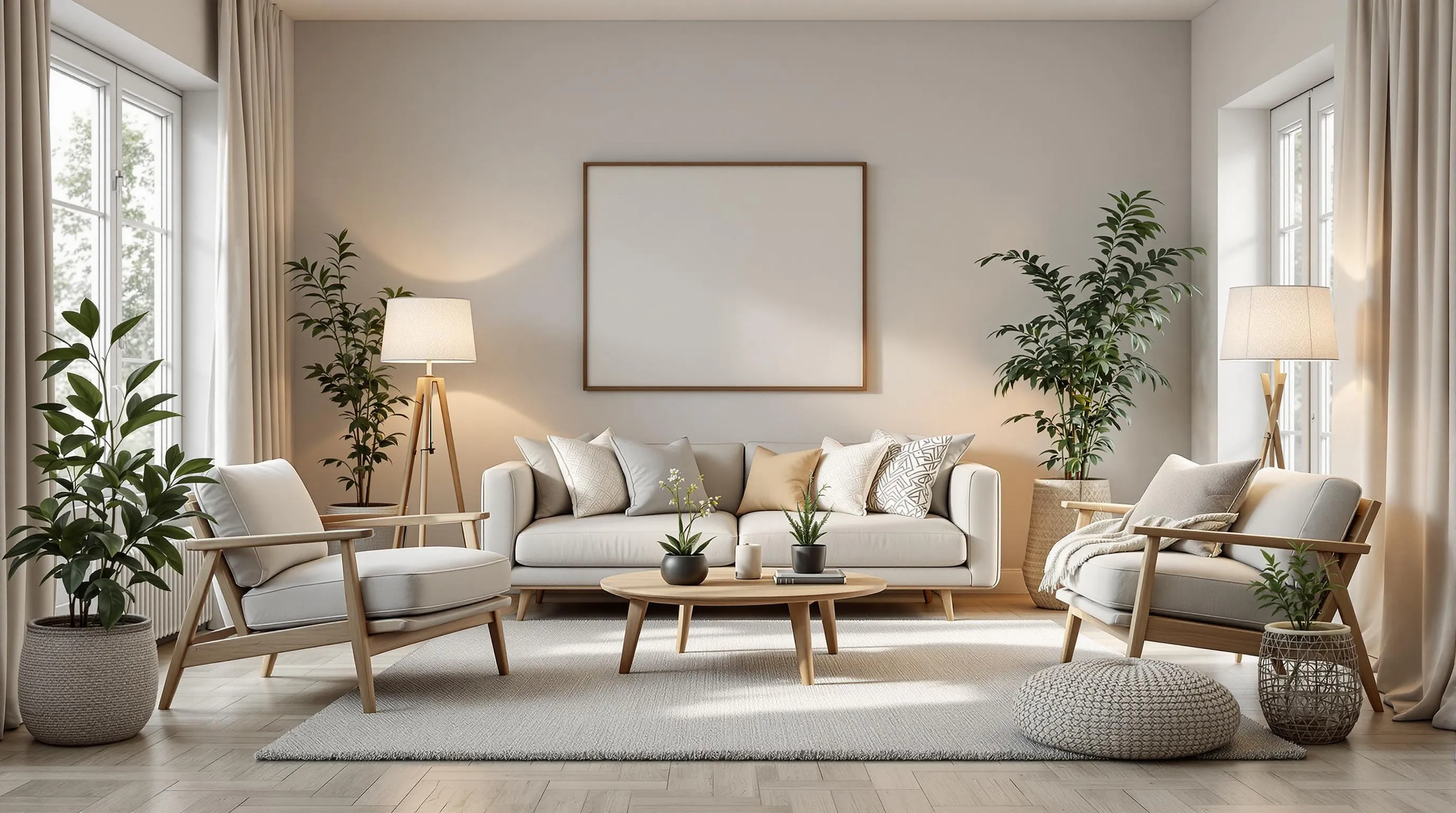
Embrace Neutral Color Palettes
We’ve found that serene color schemes are fundamental to clutter-free hygge spaces. Light gray, cream, and soft white tones create a peaceful foundation that reduces visual noise while maintaining warmth. These muted hues establish visual harmony throughout your living room, allowing the eye to rest rather than becoming overwhelmed by competing colors. Neutral walls and major furniture pieces provide the perfect backdrop for intentional pops of texture, making the space feel both orderly and inviting.
Select Minimalist Furniture with Purpose
Furniture selection plays a crucial role in balancing openness with comfort. Clean-lined pieces with tapered legs and rounded edges maintain visual flow while offering necessary functionality. Limit your furniture to true essentials—a comfortable sofa, perhaps an armchair or two, and minimal accent tables—to prevent the room from feeling crowded. Each piece should serve a clear purpose, contributing to both the room’s function and its aesthetic without overwhelming the space.
Incorporate Natural Materials and Textures
Natural elements bring warmth to minimal spaces without contributing to visual clutter. Wood accents in tables, flooring, or decorative objects add organic texture and grounding elements. Wool rugs, linen throws, and cotton pillows introduce tactile comfort while maintaining the room’s clean aesthetic. These materials create sensory richness that satisfies our need for coziness without requiring many objects or busy patterns.
Carry out Mindful Storage Answers
Storage remains essential for maintaining clutter-free hygge spaces. Woven baskets and wooden storage boxes offer practical containment for everyday items while complementing the natural aesthetic. Built-in shelving or furniture with hidden storage compartments keeps necessary items accessible yet out of sight. Regularly assess what deserves display space, keeping most surfaces clear to emphasize the calm, intentional atmosphere of your living room.
Layer Textiles Strategically
Cozy textile layers don’t have to mean excess. Select a few high-quality blankets and pillows in complementary neutral tones rather than amassing many options. Position these thoughtfully—a single throw draped over the sofa arm, two or three cushions arranged with intention—to create warmth without overwhelm. Quality trumps quantity; one luxurious wool blanket offers more authentic hygge comfort than several synthetic alternatives.
Create Focused Social Zones
Dedicated conversation areas foster connection without requiring elaborate setups. Arrange seating to naturally encourage interaction, with chairs angled slightly toward each other and small tables within easy reach for beverages. Soft lighting from table lamps or floor lamps defines these zones while creating the warm glow essential to hygge. These purposeful arrangements promote togetherness while maintaining the room’s uncluttered flow.
Add Touches of Greenery
Plants bring life to minimal spaces without contributing to clutter. A single potted plant or fresh flower arrangement adds natural beauty and connects the indoor environment to nature. Simple, organic vessels like stoneware pots or clear glass vases complement the minimalist aesthetic while showcasing the plant itself. Greenery provides a focal point that draws the eye without requiring additional decorative elements.
Prioritize Ambient Lighting
Warm, low-level lighting creates coziness without physical clutter. Replace harsh overhead fixtures with soft lamps featuring frosted bulbs placed strategically throughout the room. Candles in simple holders add flickering warmth while maintaining the clean aesthetic. This thoughtful lighting approach transforms the atmosphere and perception of the space without adding unnecessary objects, embodying hygge’s essence of comfort through simplicity rather than accumulation.
Seasonal Hygge Living Room Adaptations for Year-Round Comfort
Creating a hygge living room isn’t just a design choice—it’s a lifestyle shift that nurtures wellbeing and contentment. By embracing soft lighting warm textiles and natural elements we’re not simply decorating but cultivating spaces that support our emotional health.
The beauty of hygge lies in its accessibility. Whether you’ve transformed your entire living room or added a few cozy touches the impact on your daily life can be profound. As you carry out these ideas remember that true hygge comes from mindfulness and appreciation of the present moment.
Your hygge journey is personal and ever-evolving. As seasons change let your space adapt while maintaining that essential feeling of warmth and welcome that makes coming home the best part of any day.
Frequently Asked Questions
What is hygge and how do you pronounce it?
Hygge (pronounced “hoo-gah”) is a Danish philosophy centered on comfort and contentment that has been embraced for centuries. It focuses on creating warm atmospheres and enjoying life’s simple pleasures, particularly during long, dark winters. Hygge evokes feelings of safety, comfort, and connection, making it particularly valuable for enhancing wellbeing in our homes.
How does hygge differ from minimalism?
While minimalism emphasizes stark aesthetics and reduction, hygge values authenticity and thoughtful abundance. Hygge embraces comfort through soft textures, warm lighting, and meaningful personal items rather than bare spaces. It’s about creating a feeling of coziness and contentment that can include carefully curated items that bring joy, unlike minimalism’s focus on eliminating possessions.
What lighting is best for a hygge living room?
Soft, layered lighting is essential for authentic hygge vibes. Use warm-toned bulbs and mix light sources at different heights. Candles are quintessential hygge elements, providing natural, flickering glow that enhances the sensory experience. Strategically place them throughout your living room to create pockets of warmth and ambiance that make ordinary evenings feel special.
What textiles should I choose for a hygge space?
Select neutral tones and natural materials like wool, linen, and cotton to create tactile warmth and calmness. Chunky knit blankets and soft throw pillows are essential elements that provide both visual warmth and physical comfort. Avoid synthetic fabrics in favor of organic options. Natural material rugs (wool, jute, or sisal) add warmth and texture while supporting the sustainability aspect of hygge living.
What colors work best in a hygge living room?
Warm, neutral tones establish a foundation of calm and simplicity in hygge spaces. Earth tones like soft browns, gentle greens, and muted blues create organic warmth, especially when paired with natural materials like wood and stone. These colors evoke feelings of safety and comfort according to color psychology. The goal is a visually cohesive and emotionally nurturing environment.
How can I incorporate natural elements into my hygge living room?
Add wooden accents and furniture in natural tones to bring warmth and character to your space. Incorporate low-maintenance indoor plants for aesthetic appeal and improved air quality. Fresh cut flowers and herb plants introduce seasonal beauty and functionality. These natural elements ground the space and enhance the connection to nature that’s fundamental to hygge philosophy.
How should I arrange furniture for a hygge living room?
Create a balance between openness and coziness with functional seating that features clean lines and rounded edges. Layer seating with plush throw blankets and cushions made from natural fabrics. Design intimate conversation areas with strategically placed furniture and warm lighting to foster meaningful connections. Consider creating cozy nooks that invite relaxation and togetherness.
How can I maintain a clutter-free hygge space?
Use serene color schemes to reduce visual noise while selecting minimalist furniture with purpose. Incorporate natural materials and textures for warmth without excess. Implement mindful storage solutions to keep necessities organized but accessible. Layer textiles strategically and create focused social zones. Add touches of greenery and prioritize ambient lighting to maintain the hygge atmosphere without clutter.
What personal touches enhance the hygge feeling?
Incorporate meaningful decorations like family photographs, children’s artwork, and heirloom pieces that tell your unique story. These personal elements create warmth and connection to what matters most. Create dedicated nooks for unplugged activities such as reading corners or analog entertainment spaces that encourage mindful presence and foster togetherness, aligning with hygge’s emphasis on authentic experiences.
Can hygge improve wellbeing?
Yes, research indicates that hygge-inspired spaces can significantly reduce stress and improve mental wellbeing. They foster relaxation and meaningful social interactions while providing psychological comfort, particularly during winter months. Cozy hygge environments can help combat seasonal mood changes by increasing serotonin production. The philosophy’s focus on contentment and simple pleasures nurtures both the space and the soul.

